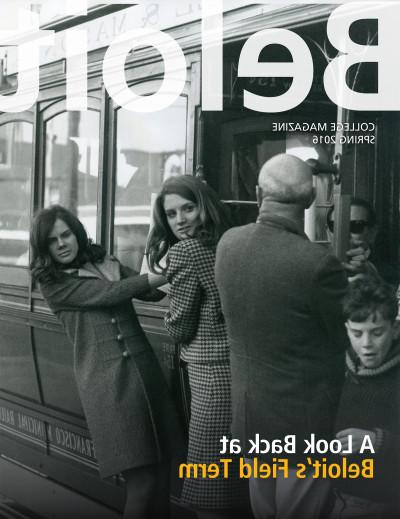Campus Archaeology

Scattered across the campus lawns, these ancient features are an indelible part of the collective memory of living at Beloit. They also have a great deal more to teach us.
Though a few of the mounds were lost to college construction, most have survived because Beloit was early to adopt archaeological preservation. In 1852, Stephen Lathrop, the college’s first science professor, mapped the mounds for the first time. In 1857, the Reverend Ralph Emerson donated $100 towards the restoration of an excavated site. The mounds were used as interactive classrooms in the mid-20th century, and in 1960, radiocarbon dating revealed that the artifacts date from as far back as 500 A.D. In the mid-1980s, Wisconsin enacted a state law that protects Native American mounds as human burial sites, placing restrictions on where and how they could be examined. Yet interest in exploring the campus mounds remained strong.
Fast forward to the Beloit arrival of Associate Professor of Anthropology Shannon Fie, whose interest in public archaeology inspired her to renew exploration around the mounds. Throughout the early 2000s, she initiated and often participated in a series of non-mound excavations around campus that yielded treasures from archaic history right up through the World War II era.
By the 2010s, research was beginning in earnest, particularly in the areas between the mounds. In 2011, Fie’s Principles of Archaeology class investigated an area in front of the World Affairs Center (formerly the college library) where a new sign was being proposed.
“We found a lot of construction debris, mostly brick,” Fie recalls. In 2013, Fie’s class did work on the area behind the Neese Theatre, south of the turtle effigy mound. In 2014, the college brought in an outside expert to test and monitor the site of an art-walk installation beside the Wright Museum. That dig revealed many archaic stone-making tools. That same year, Fie and Logan Museum Director Bill Green proposed that “cultural resources” be added to the college’s nascent Sustainability Plan, including a long-term agenda for mound preservation. When Sustainability Coordinator Lindsay Chapman sent out a call for more proposals, Fie had the idea of conducting a non-intrusive survey of the campus mounds using state-of-the-art equipment. She successfully proposed bringing to campus Jarrod Burks, the director of archaeological geophysics at Ohio Valley Archaeology, Inc.
She says the main purpose was “to get students excited about archaeology” as they searched for evidence of early Native American encampments. Fie specializes in Hopewell archaeology, a branch that focuses on sites in the Midwest from circa 100 B.C. to 400 A.D. Characterized by vast earthwork structures and a wide range of materials circulated over long distances, Hopewell archaeology studies interactions among Native American groups across the Midwest. Though many of the most notable sites are located in Ohio, findings have been recorded all over the Midwest.
Though the field of geophysics has been around since at least the 1970s, technological leaps in recent years have made it even more viable. Geophysics is a hybrid of earth sciences that uses seismic, magnetic, electric, and gravitationally based methods to study the physical layout of the planet. It can be used for everything from mineral excavation to environmental hazard research and has become popular in archaeology because it provides precise imagery of ancient sites without excavation. For the Beloit survey, three methods were used: magnetic susceptibility, electrical resistance, and ground penetrating radar, none of which disturbed the mounds.
Over an intensive week last October, Burks, Fie and her students, and several volunteers surveyed two areas of campus: a large block around Middle College containing most of the mounds, and a second block behind the Wright Museum of Art and the Neese Theatre where the campus’ famous turtle effigy mound resides. These areas were gridded into 20-by-20 meter squares, each surveyed individually by passing equipment systematically over the mounds. Afterwards, Burks patched each grid together using separate software programs to evaluate the data, then utilized a third program to blend all the layers together, along with aerial shots and his own interpretations.
Almost every survey block revealed complex features on the resulting maps. Fie consulted with College Archivist Fred Burwell’86, who provided several early campus photos that proved invaluable in making sense of the data. For example, anomalies in front of Middle College likely represent some of the earliest paths constructed on Beloit’s campus. Another anomaly in the radar data from behind Neese Theatre turned out to be the remains of an observatory that was a fixture on campus from the 1870s to the 1960s.
The survey also offers a fairly simple method to determine which mounds had been previously excavated. All of the mounds were built around 500 A.D., so they should have similar construction. However, the mounds that had been more recently excavated should have a mix of contrasting looser soil.
The data sets are still being processed, and Fie has many plans for utilizing them in the future, including developing a geographic information system, contextualizing historic pictures and utility plans, and using the information to assist facilities staff with permit requests for work near the mounds. She also hopes that the survey will help answer questions in her own research. “My real interests are in trying to locate areas of activity that were inhabited while the mounds were being built,” she says. “If people built mounds, they had to stay somewhere.”
Fie also believes that the research will prompt further discourse among students. “The hope is to raise awareness and sensitivity as to how the college community engages with the mounds,” she says. “Our students are very open to issues relating to cultural diversity, and the mounds offer an opportunity to extend these conversations to Native Americans.”




